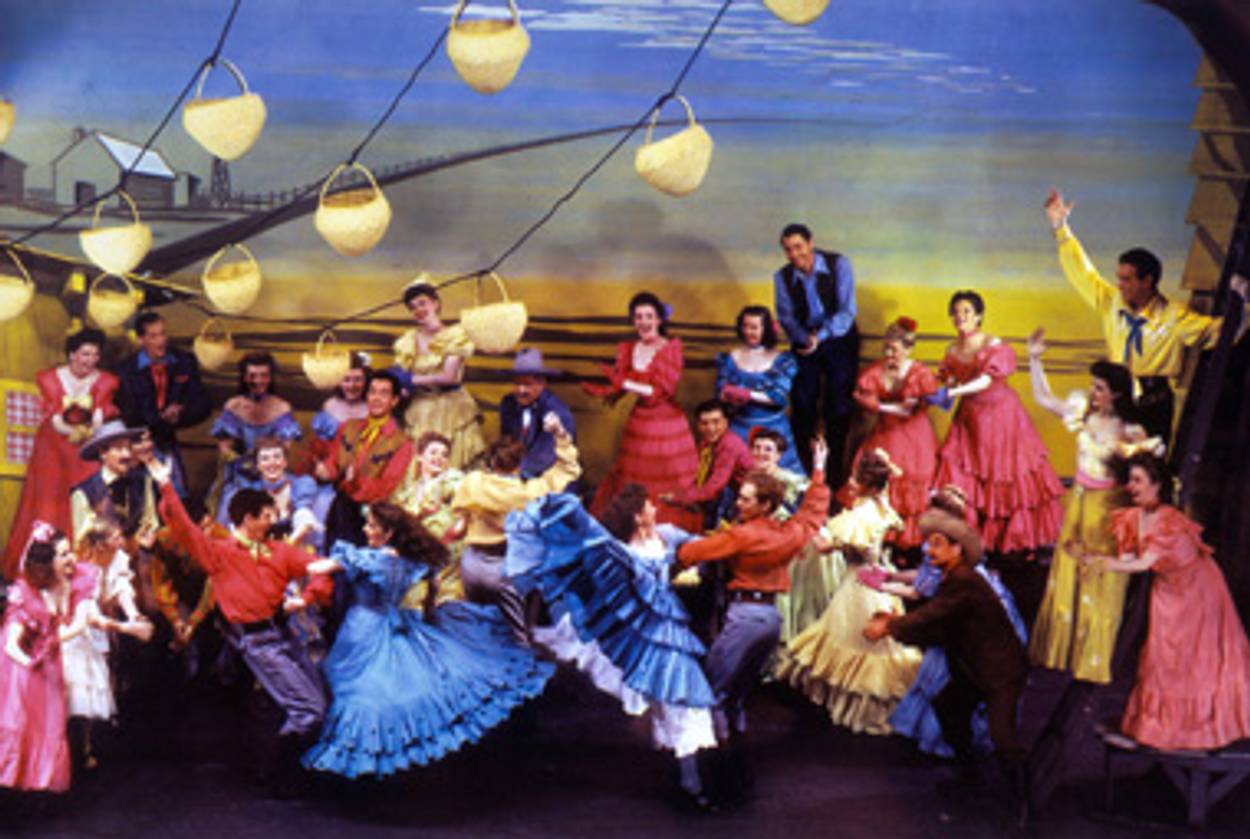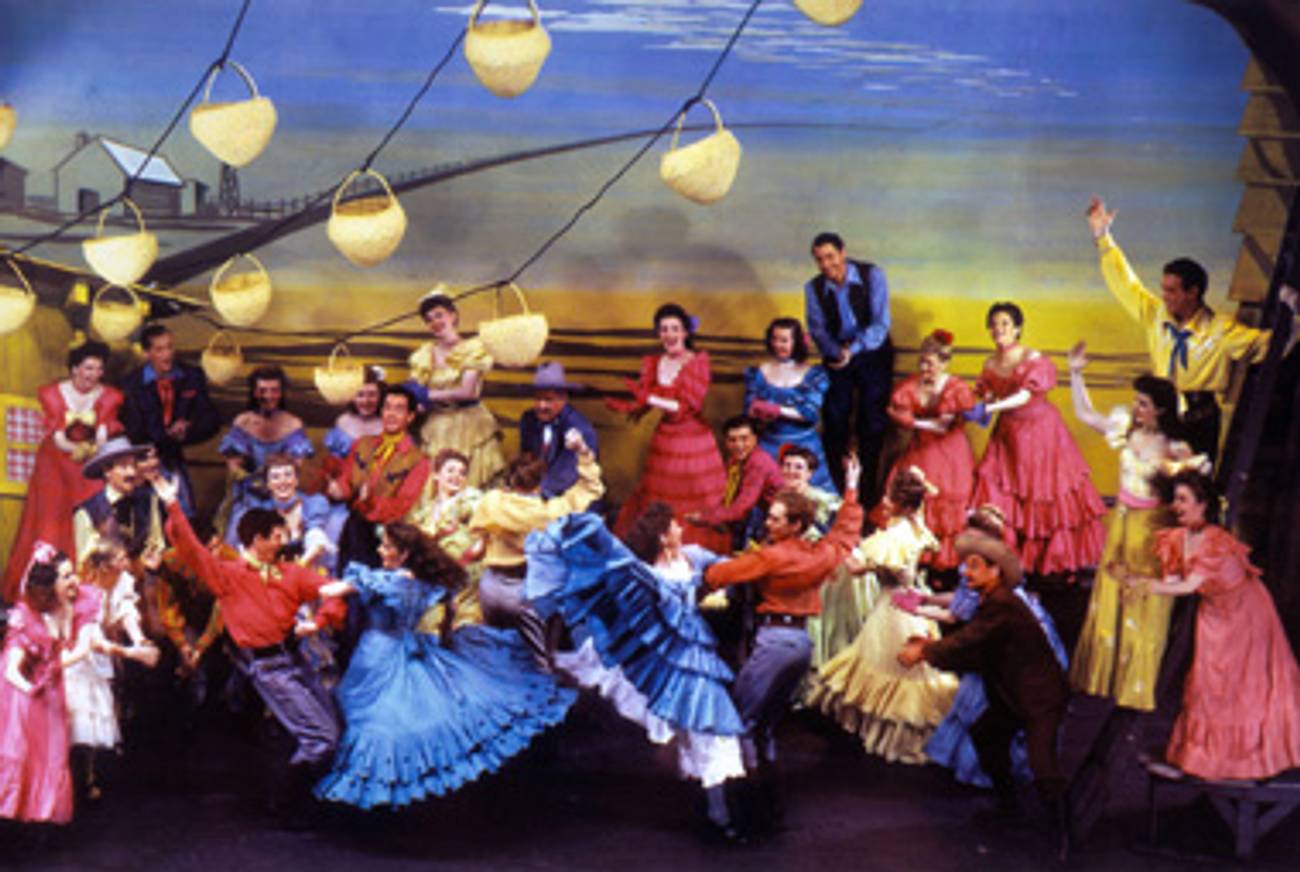Turning Point
A new history argues that it was a single play—Rodgers and Hammerstein’s Oklahoma!—that ushered in the beginning of Broadway’s Golden Age




“Integrate! Integrate!” That is what Rouben Mamoulian, the director of the ground-breaking debut production of Oklahoma!, remembered shouting at the show’s composer and lyricist, Richard Rodgers and Oscar Hammerstein. They listened, they integrated, and the result was history: For the first time, a Broadway show fused song and dance and plot and theme, to create a musical with the ambition and emotional scope of a “legitimate” play. Coming just at the midpoint of Showtime: A History of the Broadway Musical Theater (W.W. Norton), the comprehensive, engagingly written new book by Larry Stempel, the debut of Oklahoma! in 1943 marked the moment when the Broadway musical entered its Golden Age. It was, Stempel writes, “the first musical with almost immediate resonance as an American cultural artifact. Its success both created and fed on the very possibility that a Broadway musical could come to matter to the cultural life of the nation.”
There is, of course, another striking fact about this creation story, and about the whole history of the modern musical as Stempel tells it. This Midwestern epic, which seemed to capture the country’s most idealized image of itself—this story about cowboys and farmers, with names like Curly and Laurey and Jud—was being created in New York City by two Jews, with names like Hammerstein and Rogazinsky (Anglicized to Rodgers by the composer’s grandfather). No wonder they felt the importance of “integration” so keenly: What was Oklahoma! if not a triumph of integration, not just artistic but social and psychological? (David Lehman makes a similar point in Nextbook Press’s A Fine Romance: Jewish Songwriters, American Songs.)
Stempel does not tell the history of the Broadway musical as a Jewish story, and of course it is not simply a Jewish story. It is also a black story, and an Irish story, and a gay story, which is another way of saying that it is an American story. For Stempel, it all begins in the mid-19th century, when shows like Uncle Tom’s Cabin and The Black Crook combined theatrical spectacle, moral uplift, and frank eroticism to create a new kind of popular sensation. All of these elements, Stempel shows, would remain at the core of Broadway’s DNA, and the tension among them was the force propelling the musical’s rapid evolution. Throughout its history, the people who made shows and the people who watched them would debate the proper proportions of sophistication and vulgarity; but the best musicals have always had at least some of each. Try to make the musical a purely artistic form, and you end up with shows like Porgy and Bess or Candide or Assassins—all of which flopped on their first appearance and have lived subsequently in opera houses or on cast albums, not on Broadway.
Shows devoid of any artistic ambition, on the other hand, have made their money and disappeared. Today, the songs that Cole Porter and the Gershwins and Rodgers and Hart wrote for Broadway in the 1920s and 1930s are “standards,” constituting the American Songbook. But no one revives the shows themselves, which were too silly and dispensable to last. How many people who know the Gershwins’ yearning love song “Lady Be Good” know anything about the show in which it appeared, Lady, Be Good!, which ran for 10 months in 1924-25? Stempel is one of the rare ones, and his summary of the show explains the problem: “a brother-sister team of vaudevillians become ever more deeply entangled in high society … until the heroine saves her brother from penury and a loveless marriage by impersonating a Mexican heiress.” The original would have been worth seeing, since it starred Fred and Adele Astaire, but no one is calling for a revival.
That marks the main difference between Broadway before Oklahoma! and Broadway after Oklahoma!. It is the shows of the Golden Age, from the 1940s through the 1960s, that are still cherished and revived. Rodgers and Hammerstein followed their breakthrough with Carousel, South Pacific, The King and I, and The Sound of Music. Porter wrote the music for Kiss Me, Kate, and Irving Berlin for Annie Get Your Gun; Alan Jay Lerner and Frederick Loewe wrote My Fair Lady, Camelot, and Brigadoon. Then there’s West Side Story, Guys and Dolls, Gypsy, and How To Succeed in Business Without Really Trying, to name just a few of the biggest hits. Reading Stempel’s accounts of these shows and the people who made them—he focuses mainly on the writers, with occasional sidelights on important producers and directors—leaves no doubt that the Broadway musical was one of the great phases of American popular culture, like jazz before it and rock and roll afterward.
This Golden Age is usually said to have come to an end with Fiddler on the Roof, by Sheldon Harnick and Jerry Bock, which premiered in 1964 and ran on Broadway for an astonishing seven years. Is it a coincidence that this show, the most explicitly Jewish musical ever written, is the one that marked the end of an era? Writing about Fiddler, Stempel comes as close as he ever does to wondering about the Jewishness of the Broadway musical as a form:
Not only were Jews as a group involved in virtually all aspects of Broadway show business—creating, producing, disseminating, and consuming shows—but Broadway culture itself was regularly perceived as somehow Jewish in character. Indeed, the “disproportionate” Jewish presence in, on, and around Broadway altogether became a topic of interest in many discussions of twentieth-century American popular culture.
The cautious quotation marks around “disproportionate” are understandable—here, as in discussions of Hollywood, the observation that Jews have a large role in creating American culture can sometimes lead to ugly suggestions that they have too large a role. But the proportion of Jews among the makers of Broadway’s Golden Age is more than striking: Of the shows mentioned above, all but one were written by Jews. (The exception is Kiss Me, Kate, with music by Cole Porter. It is a nice example of Broadway’s alchemy that Porter, a WASP born in Indiana, became the most urbane and sophisticated, the most quintessentially “New York,” of all Broadway composers.)
It would be interesting to know what proportion of the Broadway audience, in the years 1940-1970, was also Jewish. Stempel is generally uninterested in economic and demographic questions—he is writing about the works of Broadway, not how Broadway works—and there may be no way of finding out the answer. But it is noteworthy that Broadway’s Golden Age coincided exactly with the period of American Jews’ rise into the middle class and the professions, and with the migration of New York’s Jews from the Lower East Side and Brooklyn to Long Island and Westchester—the prosperous suburbs, from which they could return for dinner and a show in Times Square.
Seeing Broadway’s classics as shows written by Jews for a largely Jewish audience does not make them parochial, or restrict their appeal to American and, indeed, international audiences. (When Fiddler went to Tokyo, Stempel writes, a Japanese producer asked the book-writer, Joseph Stein, “whether they actually understood Fiddler on the Roof in America,” because “it’s so Japanese!”) But it’s possible that, again as with Hollywood movies, Broadway musicals had such a universal appeal precisely because they were the product of Jews imagining their way into American life—a kind of imagining with worldwide resonance in the American century.
Certainly it is striking how many of the Golden Age musicals deal with exactly the subjects that most concerned American Jews in the postwar era, when the aftermath of the Holocaust and the early Civil Rights Movement put Jews at the forefront of struggles for racial and social justice. From Rodgers and Hammerstein’s South Pacific, with its anti-racist anthem “You’ve Got to Be Carefully Taught,” to West Side Story, with its vision of love struggling against prejudice, to Finian’s Rainbow, in which a leprechaun turns a racist Southern senator into a black man, the Broadway musical was drawn to a liberal vision of integration and brotherhood.
That this vision, and the music that expressed it, were never too challenging or too adventurous—that the musical happily used leprechauns to make a point about tolerance—is a reminder that Broadway was always a business first, and the musical always a popular art. If it is no longer very popular today—if jukebox musicals and mega-spectacles have left only a little space for good original shows (like the recent Grey Gardens)—this is not necessarily because, as the usual charge sheet has it, the writers of musicals have retreated into a Sondheimesque intellectuality and abrasiveness. Near the end of the book, Stempel quotes Jason Robert Brown, one of the acclaimed but not quite popular composers hailed as “Sondheim’s children”: “A commercially successful show is, by some definitions, a better work.” On Broadway, Showtime makes clear, a masterpiece isn’t a masterpiece unless it’s a hit.
Adam Kirsch is a poet and literary critic, whose books include The People and the Books: 18 Classics of Jewish Literature.
Adam Kirsch is a poet and literary critic, whose books include The People and the Books: 18 Classics of Jewish Literature.